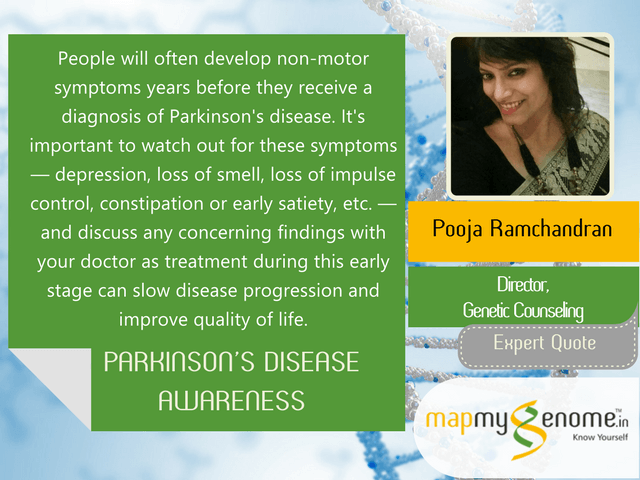Parkinson’s Disease in the Family
Apr 11, 2017
30603 Views
Sunitha Rajan is a cheerful young lady, whom friends and coworkers consider lucky – she has managed to achieve the perfect balance between work and life. Her children are well loved and do not depend on gadgets for entertainment. Her in-laws, who stay with her, consider her a blessing. She is fit and has plenty of time for her friends. At work, she is one of the most dependable team members. However, with one diagnosis, her perfect equilibrium was under threat of collapse. Her father-in-law was diagnosed with Parkinson’s Disease.
In her usual rational, cool approach, she decided to make a task list:
- Find out more and ensure the right care
- Ensure the right treatment
- Talk to a genetic counselor and find about the possible inherited risk for her husband and her children
- Train all members of her family to manage the situation without panic
Find Out More and Ensure the Right Care
The first thing Sunitha and her spouse did was to talk to the treating clinician and find out more about the disease. They found out that her father-in-law was diagnosed with a late-onset progressive neurodegenerative disorder that can affect seniors. His insomnia, sense of smell, fatigue and pain had been worsening over the years. In addition to tremors, slow movements, and loss of balance during walking, there was a little bit of slowdown in speech and cognitive process. The doctor told them about the various stages of the disease progression and suggested resources to look up. Based on extensive research, they prioritized a list of care requirements at home:
Making their home safe and fall-proof
Nobody would like to be confined to a room. With the help of service providers, their house could turn into a safe-haven. Some of the changes included:
- Levelled flooring and skid-proof surfaces with simple tile patterns and no carpets/rugs
- Secure and sturdy furniture
- Good lighting with minimal glare
- Fixtures to ease access
- Easily accessible dining area
- Appropriate fittings for the bathroom
- Teaching the children the importance of leaving nothing scattered on the floor
Ensuring round-the-clock care
It was a choice between having one member of the family take care of everything or employing a professional caregiver. Considering their finances and careers, they decided to employ a part-time caregiver. While her mother-in-law would be there to manage and monitor the situation, the caregiver would ensure adequate relaxation for all members of the family.
Physical activity
Walking as an activity can be refreshing and relaxing. They drew up a schedule where he could safely enjoy relaxed walks at the park nearby, bringing him close to nature for a short period every day. This would also ensure companionship. They also worked on including passive physical exercises and sessions with a physiotherapist.
Dietary changes
When there is a diagnosis of disease or identification of health risk in a family, nutrition becomes one of the highest priorities. Sunitha decided to consult a nutritionist to ensure a healthy diet while reducing the risk for other complications. Some of the recommendations included:
- A balanced diet with the right amount of complex carbohydrates in the form of whole grains, adequate servings of fruits and vegetables, reduced intake of fat and sugars
- Foods rich in antioxidants, while avoiding excess iron and manganese, in order to offset associated oxidative stress and cellular damage
- Moderation in some types of meat and fish, soy products, cheese, fermented drinks, etc. that may interact with medication
- Adequate hydration and intake of foods that prevent constipation
- Foods that ensure adequate bone mineral density and prevent bone thinning, to reduce chances of injury during a fall
- Timing of meals and medications to avoid food–drug and drug–drug interactions
Emotional wellness
Among the symptoms, depression was noticeable. They learned that this could only worsen with time as a side-effect of medication and due to changes in bodily and cognitive abilities. It was now vital to ensure an upbeat mood and increased mental resilience. Every member of the family made a conscious decision to focus on stress relief, companionship, and activities to ensure mental wellbeing. Regular sessions with a psychotherapist were included. Breathing and relaxation techniques were taken up.
Financial planning
In addition to insurance for the family, they worked on a building a strong contingency fund for emergencies. This also required cutting down on their luxury budget. Wealth management services also helped.
Ensure the Right Treatment
While they had full confidence on their clinician, they decided to go for a second opinion, just in case. They found out that the medication prescribed was the best. Other options available included surgery and deep brain stimulation, which may be suggested in the future, depending on the progress of the disease.
Talk to the Genetic Counselor
A talk with our genetic counselor helped calm most of their fears – chances of the disease being familial was 3-7%. They were told that there are multiple factors that contribute to Parkinson’s – diet, lifestyle, environment, and genetics. Sunitha’s husband was informed about a genetic test during the session, but they were forewarned that the presence of risk variants does not mean that the disease will definitely occur. They decided to go ahead with a predictive personal genomics test (targeted at more than 18 genes for Parkinson’s along with other disease risk variants), out of their interest. The genetic test report showed that he did not have the associated risk variants. Later, the empiric risk for having Parkinson’s was discussed – her husband would be at 2.7 to 3.5 times higher risk than someone who does not have a family history. Some environmental, lifestyle and dietary modifications were recommended by Dr. Risha Nahar Lulla, our Principal Genetic Counselor:
- Avoid exposure to pesticides (including mosquito repellants) and petrochemicals (paints, etc.)
- Avoid excessive consumption of manganese and iron through diet and supplementation
- Regular checks to maintain adequate Vitamin D and B6 levels
- Foods rich in antioxidants (e.g., caffeine, green tea, berries) and omega-3-fatty acids (e.g., walnuts, flaxseeds, and fatty fish) to reduce oxidative stress
- Diet low in dairy products and rich in fruits and vegetables
- Regular workouts with aerobic exercises
- Incorporate stress relieving activities such as Pranayam and meditation
Train All Members In the Family
All members of the family, including the children and the patient were educated about the condition, the changes that may occur, standard precautions, emergency actions in case of freezing or falls, medication timings and usage of the medication chart, mealtime care, etc.
Looking Back
Sunitha is still considered lucky – look at the way she is managing a condition that can take a toll on the family and the patient. However, Sunitha does not believe in luck. She knows how close she was to losing all that she valued — financial freedom, peace of mind, and a loving, caring family. A difficult situation can make or break a family, but tragedy can be averted with careful planning.

From Our Experts
Pooja Ramchandran is a pioneer in the field of genetic counseling in India and Director of Genetic Counseling at Mapmygenome. She has been practicing clinical genetic counseling in India since graduating from Johns Hopkins University in 2008. She is a much sought-after expert in a niche profession and, being the first genetic counselor in the country with a formal degree in genetic counseling, she is committed to establishing the genetic counseling profession in India.
She shares her view on the importance of early red flags for Parkinson’s disease:
“People will often develop non-motor symptoms years before they receive a diagnosis of Parkinson’s disease. It’s important to watch out for these symptoms — including depression, loss of smell, loss of impulse control, constipation or early satiety, etc. — and discuss any concerning findings with your doctor.”


